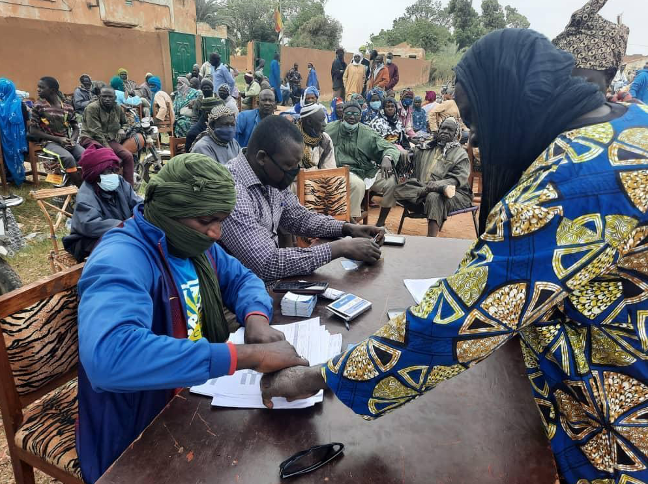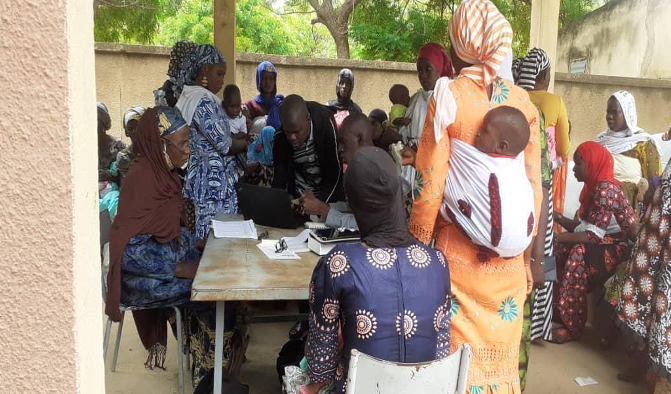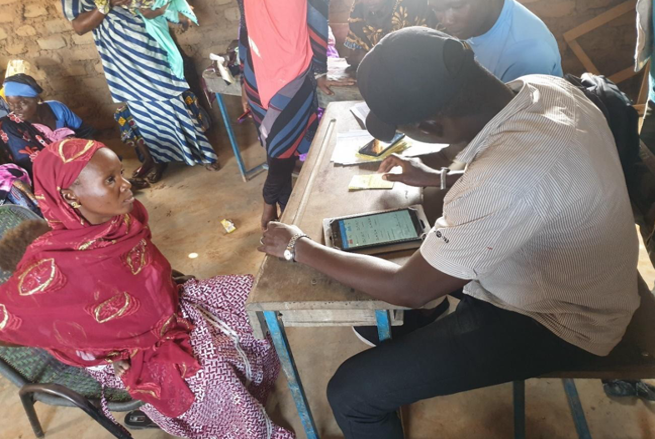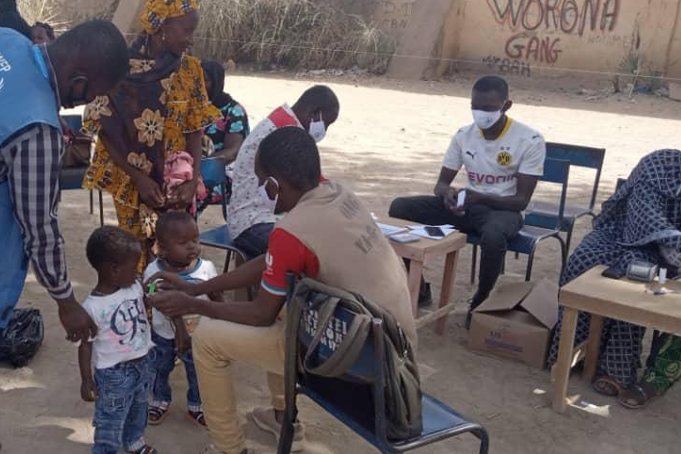One Health Newsletter
Addressing the Challenges of Hunger and Malnutrition in a Low-Income Country: Insights and Perspectives from Mali
Author
Abdoulaye Ouologuem, M.D.
Overview of Malnutrition
Malnutrition remains a major global public health issue affecting developing countries, particularly in Asia and sub-Saharan Africa.1,2 Malnutrition has no universally accepted definition. Still, it is mostly associated with “under-nutrition” or the deficiency of a wide range of nutrients (macro-and micronutrients), thereby adversely affecting body composition, function, and clinical outcome.3,4 Malnutrition is a critical risk factor for illness and death, particularly in pregnant women and children in their first 1000 days of life, with a long-term effect on the child’s overall development.4,5 Globally, every day, 25,000 people, including over 10,000 children, lose their lives due to hunger and its related causes.6 To address the problem of malnutrition, a global collaborative approach is needed. In 2019, 193 countries agreed to work towards a better future through 17 Sustainable Development Goals (SDGs).8 The second goal of the SDGs is “Zero Hunger” which targets ending all forms of malnutrition by 2030.8
Poverty is considered the main underlying cause of malnutrition.9,10 Limited financial resources create an unstable situation that hinders people’s access to safe, sufficient, and nutritious food.11 When people experience food insecurity, this compromises people’s ability to acquire the nutrients required to perform daily activities.12 While there are effective treatment protocols for malnutrition, access to formal health services, particularly in rural areas, hamper patients from receiving medical attention.13
Overcoming Malnutrition in Mali
Mali is a landlocked country in West Africa with a population of 23,293,698 in 2023.14 The country’s economy is mainly based on agriculture and mining (gold). Mali has one of the highest population growth rates in the world with a fertility rate of 6.3 children per woman.16 Malnutrition is a public health issue in Mali specifically among vulnerable groups including children under the age of five, pregnant and breast-feeding women, and persons over age 65. Other key drivers of malnutrition include poverty, early childbearing, rapid population growth, low education rates (particularly among women), and the impact of climate change.15
Access to food, clean water, and public transportation is significantly challenging in many rural areas. Families purchase foods from local stores, but limited family income restricts their ability to buy various foods. Few families own refrigerators; thus, most households only purchase a small amount of fresh produce to be cooked for a few days. In rural areas, low-income families often prioritize other daily living expenses, so owning a motorcycle is considered a luxury. Most families rely on bicycles or farm animals, such as horses, to travel long distances. Access to some places, such as many villages in remote areas, can only be achieved by using small boats during the rainy season. Motorcycles or bicycles and even animals are transported on small boats to cross rivers. These conditions limit the authorities’ ability to provide food and healthcare assistance to people in need.
National Strategic Tools for Assessment, Prevention, and Treatment of Malnutrition in Mali
In 2017, the country revised the “Protocole de Prise en Charge Intégrée de la Malnutrition Aiguë au Mali” (also known as Protocol for Integrated Treatment of Acute Malnutrition in Mali), through the leadership of the Ministry of Health and Social Development, in collaboration with National Directorate of Health, United Nations (UN) agencies, non-government organizations, and other relevant partners. as this reference document aims to facilitate the harmonization of activities, improve the quality of community management, and reduce the mortality and morbidity to prevent and treat malnutrition in Mali.16
Experts have used the Integrated Food Security Phase Classification (IPC) to evaluate annual food security and malnutrition in the country in recent years. This tool, which classifies the severity of food insecurity in different settings, uses a wide range of data such as food consumption levels, livelihood status, nutritional status, and mortality rates. Additionally, the Standardized Monitoring and Assessment of Relief and Transitions (SMART) survey is another tool used to evaluate the prevalence of malnutrition among children aged 6-59 months. The nutritional data in the SMART survey is critical for determining the IPC phase classification in each area. In a recent study using these tools, results showed that nearly one and a half million children under the age of five (745,000 girls and 733,000 boys) were expected to suffer from acute malnutrition from June 2022 to May 2023, among which 367,000 severe acute malnutrition cases in Mali.17

A participant was recorded through fingerprinting before food distribution in the Segou region, Niono cercle. January 2022. (Photo Credits: Abdoulaye Ouologuem, WFP-Mali/Mopti).

Participants’ lists are being checked in Tamani village, Baroueli circle, Segou region. (Photo credits: Moussa Koné, NGO GAAS-Mali, WFP-Mali/Mopti).
Other Initiatives to Fight Against Malnutrition
In April 2022, Mali launched the Multi-Sectoral Nutrition Action Plan (PAMN) 2021-2025, along with a commitment to support the strategic objectives of the Scaling Up Nutrition (SUN) Movement, to fight malnutrition. This movement aims to make nutrition a political and financial priority in the country and underscores the support to align with the targets of the 2030 SDG agenda by reinforcing partnerships in the fight against malnutrition.18 Besides that, the national protocol recommends implementing passive screening, such as systematically screening all children who visit healthcare facilities, for the early diagnosis of malnutrition. This approach ensures that families of affected children are given proper guidance in treating malnutrition before the condition worsens.16

A local NGO agent verifying the credentials of a participant In Boidie village, Baroueli Circle, Segou region. (Photo credits: Abdoulaye Ouologuem, WFP-Mali/Mopti).
Meanwhile, several initiatives from UN agencies and national and international non-governmental organizations are also supporting the Malian government’s efforts in fighting against malnutrition. A grassroots approach called Community Nutrition Groups (GSANS) is another initiative from the national protocol to prevent malnutrition among children, and pregnant and breastfeeding women at the community level. The GSANS are groups of volunteers who support nutrition programs in their communities by implementing activities that promote good nutrition, such as pregnant women’s counseling, to explain the importance of pre-natal and post-natal consultation, the advantages of breastfeeding, and proper infant nutrition. Meanwhile, children will be screened for malnutrition using the mid-upper arm circumference (MUAC) tapes, which help identify cases of malnutrition. Community Nutrition Groups also educate women on how to properly prepare nutrient-rich porridge for children using locally available ingredients in the community.19

An agent from a local NGO screening children during food distribution in Niono Circle, Segou region. (Photo Credits: Youma KOITA, WFP-Mali/Mopti).
During lean seasons, a period between harvests that lasts from May to August, the government supports food distribution programs to assist low-income households based on the following criteria: lower income, head of family, disabled person, and children under five in the family. In collaboration with community leaders and partners supporting the government’s initiatives, low-income families are identified based on specific criteria. A partnership is established with local traders that aims at supporting local businesses. Distributions are scheduled according to a plan established with all the stakeholders to meet at a suitable time and date for participants to attend. Some family members, including women with their children, walk very long distances (up to three miles) to get to the distribution point. Other people pay a fee for transport with animals such as horses. Fresh fruit and vegetables are avoided due to a lack of facilities such as refrigerators to keep them for long periods. Through this program, families receive a diverse set of nutritious foods (e.g. powdered baobab fruit, peanuts, and beans) to prevent malnutrition in low-income households.
Despite numerous political, social, and economic challenges affecting the malnutrition rate in the country, the government of Mali and its local and international partners are working together to combat the growing public health issue of malnutrition and reduce its negative impact on economic productivity.
References
- Schofield C, Ashworth A. Why have mortality rates for severe malnutrition remained so high? Bull World Health Organ1996; 74:223-9.
- Food and Agriculture Organization of the United Nations. Undernourishment around the world.: The state of food insecurity in the world 2004. Rome: The Organization; 2004.
- Elia M, British Association for Parenteral and Enteral Nutrition Advisory Group on Malnutrition. Guidelines for Detection and Management of Malnutrition. BAPEN; 2000.
- Saunders J, Smith T. Malnutrition: causes and consequences. Clin Med (Lond). 2010;10(6):624-627.
- Likhar A, Patil MS. Importance of maternal nutrition in the first 1,000 days of life and its effects on child development: a narrative review. Cureus. 2022;14(10) e30083. doi: 10.7759/cureus.30083.
- Holmes J. Losing 25,000 to Hunger Every Day. UN Chronicle. Accessed September 20, 2024. https://www.un.org/en/chronicle/article/losing-25000-hunger-every-day
- Sustainable Development Goals. Practical Action. Accessed June 30, 2024. https://practicalaction.org/sustainable-development-goals/
- Goal 2: Zero Hunger. The Global Goals. Accessed June 30, 2024. https://www.globalgoals.org/goals/2-zero-hunger/
- Duncan T, Commission on Macroeconomics and Health. Health, Nutrition and Economic Prosperity: A Microeconomic Perspective. CMH Working Paper No. WG1:7. World Health Organization; 2001.
- Sachs J.D, McArthur J.W. The Millennium Project: a plan for meeting the Millennium Development Goals. Lancet. 2005; 365:347-353.
- Peña M, Bacallao J. Malnutrition and poverty. Annu Rev Nutr. 2002; 22:241-253. doi: 10.1146/annurev.nutr.22.120701.141104
- Banerjee A, Duflo E. More than 1 billion people are hungry in the world. Foreign Policy. 2011: 66-72.
- Müller O, Krawinkel M. Malnutrition and health in developing countries. CMAJ. 2005;173(3):279-286.
- World Bank Group. Population, Total - Mali. World Bank Data. Accessed June 30, 2024. https://data.worldbank.org/indicator/SP.POP.TOTL?locations=ML
- Mali: Nutrition Profile. Accessed June 30, 2024. https://www.usaid.gov/sites/default/files/2022-05/Copy_of_tagged_Mali-Nutrition-Profile.pdf.
- Protocol for Integrated Treatment of Acute Malnutrition in Mali. Accessed June 30, 2024.
- République du Mali Vue d'ensemble. Accessed June 30, 2024. https://www.nutritioncluster.net/sites/nutritioncluster.com/files/2023-01/IPC_Mali_Acute_Malnutrition_Jun2022May2023_Report_fr.pdf.
- Scaling Up Nutrition Movement. The Scaling Up Nutrition (SUN) Movement welcomes Mali's launch of its Multi-Sectoral Nutrition Action Plan 2021-2025 and SUN 3.0 Strategy. Scaling Up Nutrition. 2022. Accessed June 30, 2024. https://scalingupnutrition.org/news/scaling-nutrition-sun-movement-welcomes-malis-launch-its-multi-sectoral-nutrition-action-plan
- Save the Children’s Resource Centre. Community Nutrition Groups. YouTube. 2020. Accessed June 30, 2024. https://www.youtube.com/watch?v=PswK6bMwMU4&list=PL-QMVR1hIPbalpqhdOayuLdRJ-sFPmpta.